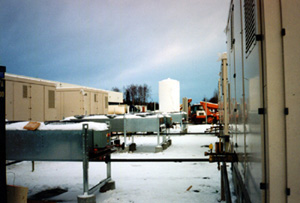FEMP Focus Newsletter - October 2000
USPS Installs One-Megawatt Fuel Cell System in Alaska
The U.S. Postal Service (USPS) and Alaska's largest electric utility have delivered another stamp of approval for energy efficiency and protecting the environment. USPS and Alaska's largest electric utility announced August 9, 2000, that the nation's largest commercial fuel cell system began generating power at the Anchorage Mail Processing Center. The one-megawatt system consists of five fuel cells manufactured by International Fuel Cells. The Chugach Electric Association, Inc., installed and will operate the system for the USPS.
 Installation of fuel cells doesn't stop in bad weather. Chugach was prepared for the snow to hit and used that as another reason for choosing such a large installation area, an advantage of which is low snow removal maintenance costs. |
In a ribbon-cutting ceremony at the Anchorage Mail Processing Center, U.S. Senator Ted Stevens and U.S. Postmaster General Bill Henderson inaugurated service of a one-megawatt fuel cell system now generating power at the postal facility.
Five fuel cells, connected in parallel to produce one megawatt of electricity, now are the primary source of power for the Anchorage facility, located adjacent to Ted Stevens Anchorage International Airport. The fuel cells are part of the local electric utility's grid—operating in parallel with the grid, dispatched from the utility's central system dispatch center. Excess power from the fuel cells is fed into the Chugach electric grid.
The fuel cells that make up the system were developed and manufactured by International Fuel Cells (IFC), South Windsor, CT, a subsidiary of United Technologies Corporation.
Congratulating those involved with the fuel cell project, Postmaster General Henderson said: "The mission of the Postal Service is to provide cost-effective, high quality, and consistent mail service to our customers, in all kinds of weather and in all types of conditions. Clearly, this fuel cell installation will add to our ability to serve postal customers well throughout the great state of Alaska, and also help us safeguard its unique environment.
"We are proud to partner with the various governmental agencies and businesses involved, and with Senator Stevens in delivering this successful and environmentally beneficial fuel cell project," the postmaster general added.
"I applaud Chugach Electric for its efforts in this fuel cell project and the Postal Service for its continued commitment to serving Alaska," Senator Ted Stevens said of the fuel cell. He went on to note, "The Postal Service's leadership and experience in connecting all Alaska communities, and Chugach Electric's continued dedication and innovation in providing energy to Alaskans, are stronger through this project."
Senator Stevens added: "This fuel cell project, and the benefits it brings to our state, opens the door to new and creative ways to produce energy in a cost effective and clean manner. I hope others will look into using this power source as a building block for future energy needs in Alaska and I congratulate Chugach Electric and the Postal Service on this successful venture."
New technology, developed for the project and largely funded by the DOD, Army Corps of Engineers, Construction Engineering and Research Laboratories (CERL), assures that the facility will continue to operate uninterrupted during a grid outage. If there is a grid outage, the fuel cells transition to operate as an independent system, continuing to power the Postal Service facility. The automatic transition will appear seamless, eliminating the need for conventional non-interruptible power supplies and stand_by generators.
Heat recovery from the fuel cells will help provide space heating to the facility, increasing the overall fuel efficiency of the Postal Service Center. As a result, less fuel will be needed than from conventional systems.
Fuel cells do not burn fuel so the system eliminates air emissions normally associated with acid rain and smog, and dramatically reduces those associated with global warming. Compared with electricity generated from the average combustion-based processes in the Lower 48, a one-megawatt fuel cell system would save more than 200,000 pounds of air pollution and 11 million pounds of carbon dioxide from the atmosphere during each year of operation.
Research, development, manufacture and installation of the approximately $5.5 million fuel cell system was funded, in part, by Chugach, the U.S. Postal Service, U. S. Department of Defense, Cooperative Research Network of the National Rural Electric Cooperative Association, and the Electric Power Research Institute. The control system for the project was developed and funded by the DOD, U. S. Army Corps of Engineers, CERL.
"This project helps position Chugach in the emerging competitive electric utility industry," said Eugene Bjornstad, General Manager of Chugach. "Fuel cells allow us to offer customers options."
"This project is another example of how our fuel cells can serve the
commercial power market," said William T. Miller, IFC President. "We are
especially pleased to showcase the assured-power capability for a highly
visible customer like the Postal Service."
